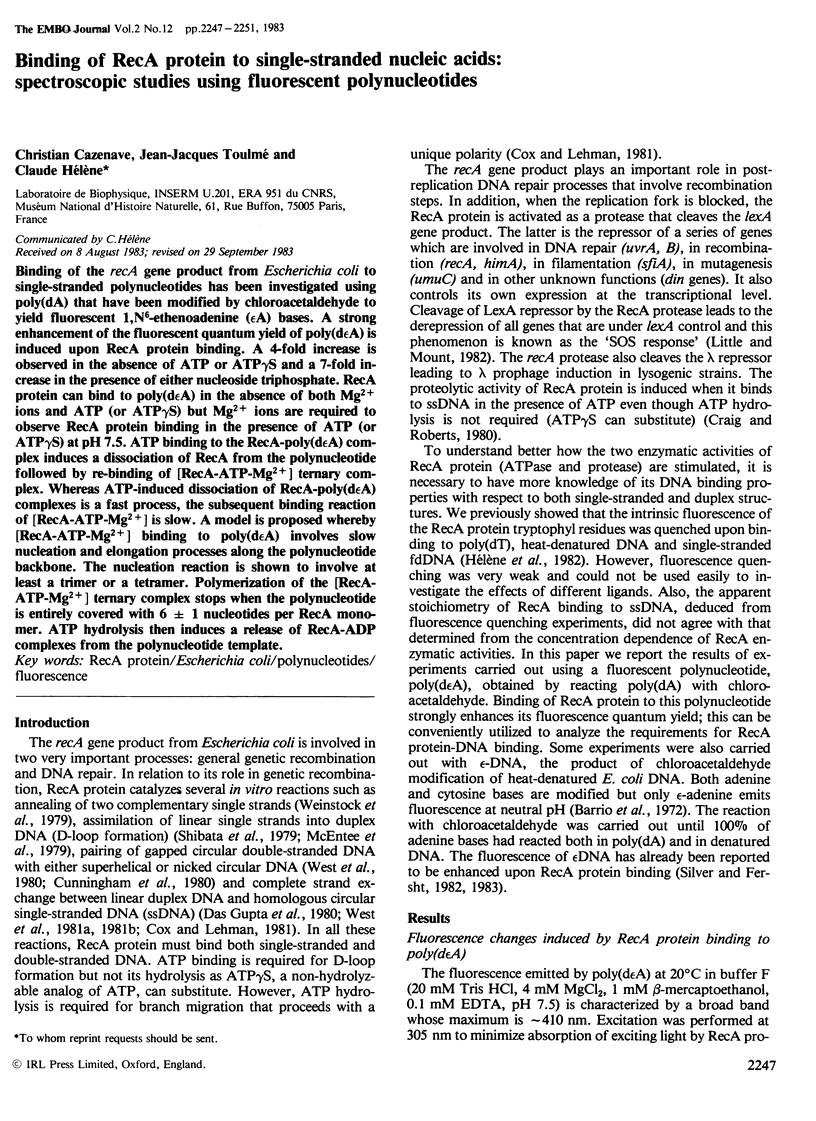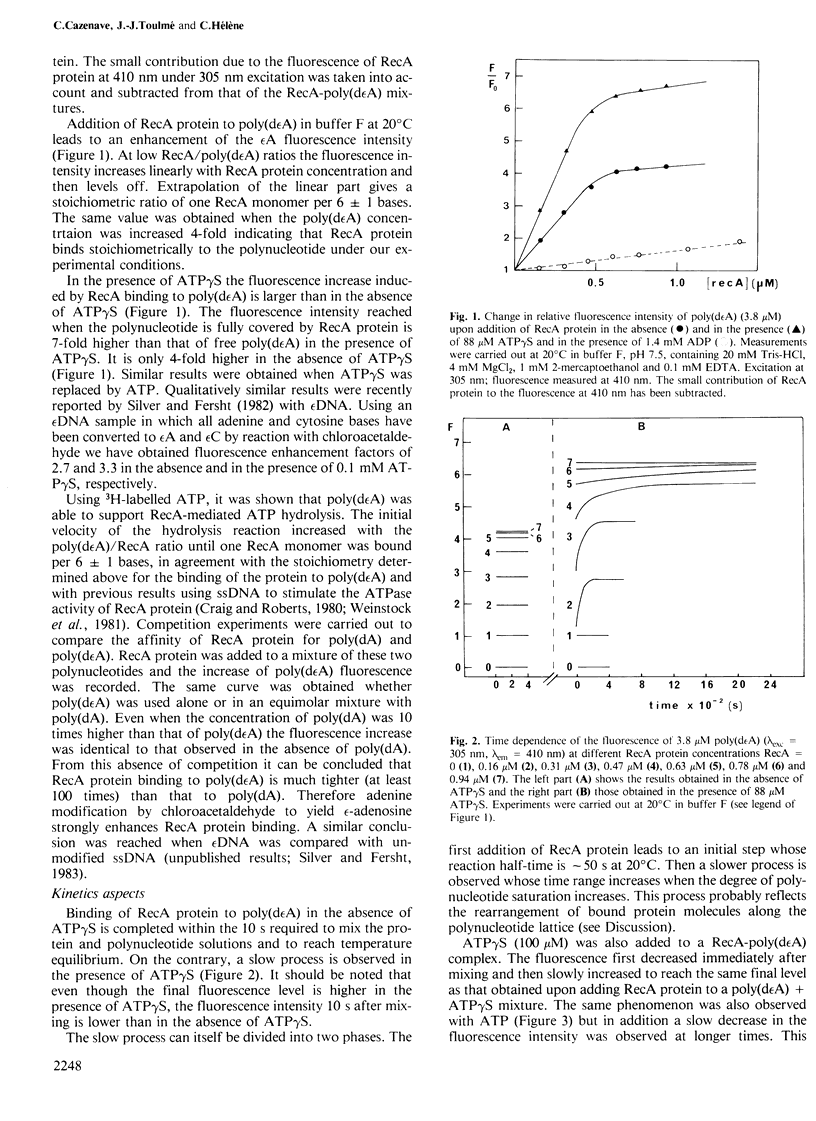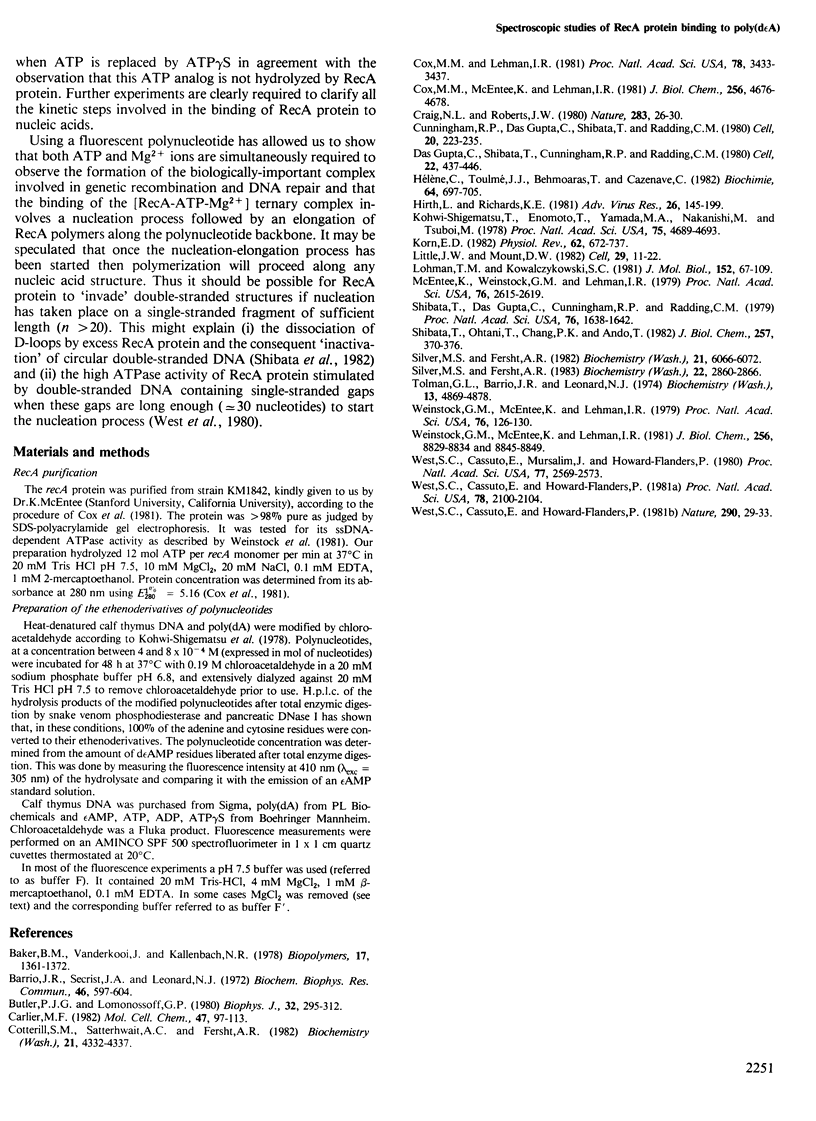Abstract
Binding of the recA gene product from Escherichia coli to single-stranded polynucleotides has been investigated using poly(dA) that have been modified by chloroacetaldehyde to yield fluorescent 1,N6-ethenoadenine (epsilon A) bases. A strong enhancement of the fluorescent quantum yield of poly(d epsilon A) is induced upon RecA protein binding. A 4-fold increase is observed in the absence of ATP or ATP gamma S and a 7-fold increase in the presence of either nucleoside triphosphate. RecA protein can bind to poly(d epsilon A) in the absence of both Mg2+ ions and ATP (or ATP gamma S) but Mg2+ ions are required to observe RecA protein binding in the presence of ATP (or ATP gamma S) at pH 7.5. ATP binding to the RecA-poly(d epsilon A) complex induces a dissociation of RecA from the polynucleotide followed by re-binding of [RecA-ATP-Mg2+] ternary complex. Whereas ATP-induced dissociation of RecA-poly(d epsilon A) complexes is a fast process, the subsequent binding reaction of [RecA-ATP-Mg2+] is slow. A model is proposed whereby [RecA-ATP-Mg2+] binding to poly(d epsilon A) involves slow nucleation and elongation processes along the polynucleotide backbone. The nucleation reaction is shown to involve at least a trimer or a tetramer. Polymerization of the [RecA-ATP-Mg2+] ternary complex stops when the polynucleotide is entirely covered with 6 +/- 1 nucleotides per RecA monomer. ATP hydrolysis then induces a release of RecA-ADP complexes from the polynucleotide template.
Full text
PDF




Selected References
These references are in PubMed. This may not be the complete list of references from this article.
- Barrio J. R., Secrist J. A., 3rd, Leonard N. J. Fluorescent adenosine and cytidine derivatives. Biochem Biophys Res Commun. 1972 Jan 31;46(2):597–604. doi: 10.1016/s0006-291x(72)80181-5. [DOI] [PubMed] [Google Scholar]
- Butler P. J., Lomonossoff G. P. RNA-protein interactions in the assembly of tobacco mosaic virus. Biophys J. 1980 Oct;32(1):295–312. doi: 10.1016/S0006-3495(80)84958-7. [DOI] [PMC free article] [PubMed] [Google Scholar]
- Carlier M. F. Guanosine-5'-triphosphate hydrolysis and tubulin polymerization. Review article. Mol Cell Biochem. 1982 Sep 3;47(2):97–113. doi: 10.1007/BF00234410. [DOI] [PubMed] [Google Scholar]
- Cotterill S. M., Satterthwait A. C., Fersht A. R. recA protein from Escherichia coli. a very rapid and simple purification procedure: binding of adenosine 5'-triphosphate and adenosine 5'-diphosphate by the homogeneous protein. Biochemistry. 1982 Aug 31;21(18):4332–4337. doi: 10.1021/bi00261a023. [DOI] [PubMed] [Google Scholar]
- Cox M. M., Lehman I. R. recA protein of Escherichia coli promotes branch migration, a kinetically distinct phase of DNA strand exchange. Proc Natl Acad Sci U S A. 1981 Jun;78(6):3433–3437. doi: 10.1073/pnas.78.6.3433. [DOI] [PMC free article] [PubMed] [Google Scholar]
- Cox M. M., McEntee K., Lehman I. R. A simple and rapid procedure for the large scale purification of the recA protein of Escherichia coli. J Biol Chem. 1981 May 10;256(9):4676–4678. [PubMed] [Google Scholar]
- Craig N. L., Roberts J. W. E. coli recA protein-directed cleavage of phage lambda repressor requires polynucleotide. Nature. 1980 Jan 3;283(5742):26–30. doi: 10.1038/283026a0. [DOI] [PubMed] [Google Scholar]
- Cunningham R. P., DasGupta C., Shibata T., Radding C. M. Homologous pairing in genetic recombination: recA protein makes joint molecules of gapped circular DNA and closed circular DNA. Cell. 1980 May;20(1):223–235. doi: 10.1016/0092-8674(80)90250-0. [DOI] [PubMed] [Google Scholar]
- DasGupta C., Shibata T., Cunningham R. P., Radding C. M. The topology of homologous pairing promoted by RecA protein. Cell. 1980 Nov;22(2 Pt 2):437–446. doi: 10.1016/0092-8674(80)90354-2. [DOI] [PubMed] [Google Scholar]
- Helene C., Toulme J. J., Behmoaras T., Cazenave C. Mechanisms for the recognition of chemically-modified DNA by peptides and proteins. Biochimie. 1982 Aug-Sep;64(8-9):697–705. doi: 10.1016/s0300-9084(82)80113-2. [DOI] [PubMed] [Google Scholar]
- Hirth L., Richards K. E. Tobacco mosaic virus: model for structure and function of a simple virus. Adv Virus Res. 1981;26:145–199. doi: 10.1016/s0065-3527(08)60423-6. [DOI] [PubMed] [Google Scholar]
- Kohwi-Shigematsu T., Enomoto T., Yamada M. A., Nakanishi M., Tsuboi M. Exposure of DNA bases induced by the interaction of DNA and calf thymus DNA helix-destabilizing protein. Proc Natl Acad Sci U S A. 1978 Oct;75(10):4689–4693. doi: 10.1073/pnas.75.10.4689. [DOI] [PMC free article] [PubMed] [Google Scholar]
- Korn E. D. Actin polymerization and its regulation by proteins from nonmuscle cells. Physiol Rev. 1982 Apr;62(2):672–737. doi: 10.1152/physrev.1982.62.2.672. [DOI] [PubMed] [Google Scholar]
- Little J. W., Mount D. W. The SOS regulatory system of Escherichia coli. Cell. 1982 May;29(1):11–22. doi: 10.1016/0092-8674(82)90085-x. [DOI] [PubMed] [Google Scholar]
- Lohman T. M., Kowalczykowski S. C. Kinetics and mechanism of the association of the bacteriophage T4 gene 32 (helix destabilizing) protein with single-stranded nucleic acids. Evidence for protein translocation. J Mol Biol. 1981 Oct 15;152(1):67–109. doi: 10.1016/0022-2836(81)90096-6. [DOI] [PubMed] [Google Scholar]
- McEntee K., Weinstock G. M., Lehman I. R. Initiation of general recombination catalyzed in vitro by the recA protein of Escherichia coli. Proc Natl Acad Sci U S A. 1979 Jun;76(6):2615–2619. doi: 10.1073/pnas.76.6.2615. [DOI] [PMC free article] [PubMed] [Google Scholar]
- Shibata T., DasGupta C., Cunningham R. P., Radding C. M. Purified Escherichia coli recA protein catalyzes homologous pairing of superhelical DNA and single-stranded fragments. Proc Natl Acad Sci U S A. 1979 Apr;76(4):1638–1642. doi: 10.1073/pnas.76.4.1638. [DOI] [PMC free article] [PubMed] [Google Scholar]
- Shibata T., Ohtani T., Chang P. K., Ando T. Role of superhelicity in homologous pairing of DNA molecules promoted by Escherichia coli recA protein. J Biol Chem. 1982 Jan 10;257(1):370–376. [PubMed] [Google Scholar]
- Silver M. S., Fersht A. R. Direct observation of complexes formed between recA protein and a fluorescent single-stranded deoxyribonucleic acid derivative. Biochemistry. 1982 Nov 23;21(24):6066–6072. doi: 10.1021/bi00267a007. [DOI] [PubMed] [Google Scholar]
- Silver M. S., Fersht A. R. Investigation of binding between recA protein and single-stranded polynucleotides with the aid of a fluorescent deoxyribonucleic acid derivative. Biochemistry. 1983 Jun 7;22(12):2860–2866. doi: 10.1021/bi00281a014. [DOI] [PubMed] [Google Scholar]
- Tolman G. L., Barrio J. R., Leonard N. J. Chloroacetaldehyde-modified dinucleoside phosphates. Dynamic fluorescence quenching and quenching due to intramolecular complexation. Biochemistry. 1974 Nov 19;13(24):4869–4878. doi: 10.1021/bi00721a001. [DOI] [PubMed] [Google Scholar]
- Weinstock G. M., McEntee K., Lehman I. R. ATP-dependent renaturation of DNA catalyzed by the recA protein of Escherichia coli. Proc Natl Acad Sci U S A. 1979 Jan;76(1):126–130. doi: 10.1073/pnas.76.1.126. [DOI] [PMC free article] [PubMed] [Google Scholar]
- Weinstock G. M., McEntee K., Lehman I. R. Hydrolysis of nucleoside triphosphates catalyzed by the recA protein of Escherichia coli. Steady state kinetic analysis of ATP hydrolysis. J Biol Chem. 1981 Aug 25;256(16):8845–8849. [PubMed] [Google Scholar]
- West S. C., Cassuto E., Howard-Flanders P. Homologous pairing can occur before DNA strand separation in general genetic recombination. Nature. 1981 Mar 5;290(5801):29–33. doi: 10.1038/290029a0. [DOI] [PubMed] [Google Scholar]
- West S. C., Cassuto E., Howard-Flanders P. recA protein promotes homologous-pairing and strand-exchange reactions between duplex DNA molecules. Proc Natl Acad Sci U S A. 1981 Apr;78(4):2100–2104. doi: 10.1073/pnas.78.4.2100. [DOI] [PMC free article] [PubMed] [Google Scholar]
- West S. C., Cassuto E., Mursalim J., Howard-Flanders P. Recognition of duplex DNA containing single-stranded regions by recA protein. Proc Natl Acad Sci U S A. 1980 May;77(5):2569–2573. doi: 10.1073/pnas.77.5.2569. [DOI] [PMC free article] [PubMed] [Google Scholar]


